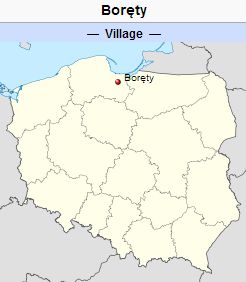Difference between revisions of "Barendt (Pomeranian Voivodeship, Poland)"
| [unchecked revision] | [checked revision] |
GameoAdmin (talk | contribs) (CSV import - 20130820) |
GameoAdmin (talk | contribs) (CSV import - 20130823) |
||
| Line 1: | Line 1: | ||
| − | [[File:Barendt.jpg|300px|thumb|right|''Barendt (now Boręty, Poland) | + | [[File:Barendt.jpg|300px|thumb|right|''Barendt (now Boręty, Poland) |
| − | Source: [http://en.wikipedia.org/wiki/Bor%C4%99ty Wikipedia Commons] | + | Source: [http://en.wikipedia.org/wiki/Bor%C4%99ty Wikipedia Commons]'']] Barendt (also known as Borente, Barent, and Barend; now known as Boręty and Boręty Pierwsze; coordinates: 54.1174, 18.847 [54° 7′ 2″ N, 18° 50′ 49″ E]; population in 1905, 452; in 2012, 182) is located approximately 5 kilometres (3 miles) north-west of [[Groß Lichtenau (Pomeranian Voivodeship, Poland)|Lichnowy]] (Groß Lichtenau), 16 km. (10 mi.) north-west of Malbork ([[Marienburg (Pomeranian Voivodeship, Poland)|Marienburg]]), 21 km. (12 mi.) south-west of Nowy Dwór Gdański ([[Tiegenhof (Pomeranian Voivodeship, Poland)|Tiegenhof]]), and 30 km. (19 mi.) south-east of the regional capital Gdańsk ([[Danzig (Poland)|Danzig]]). |
| − | |||
| − | '']] Barendt (also known as Borente, Barent, and Barend; now known as Boręty and Boręty Pierwsze; coordinates: 54.1174, 18.847 [54° 7′ 2″ N, 18° 50′ 49″ E]; population in 1905, 452; in 2012, 182) is located approximately 5 kilometres (3 miles) north-west of [[Groß Lichtenau (Pomeranian Voivodeship, Poland)|Lichnowy]] (Groß Lichtenau), 16 km. (10 mi.) north-west of Malbork ([[Marienburg (Pomeranian Voivodeship, Poland)|Marienburg]]), 21 km. (12 mi.) south-west of Nowy Dwór Gdański ([[Tiegenhof (Pomeranian Voivodeship, Poland)|Tiegenhof]]), and 30 km. (19 mi.) south-east of the regional capital Gdańsk ([[Danzig (Poland)|Danzig]]). | ||
Barendt was founded in 1321 by the commander Werner von Orseln of the Teutonic Order on 50 włókas (898 hectares). Until 1772 Barendt was located in what was known as Royal Prussia (also known as Polish Prussia) in the Kingdom of [[Poland|Poland]]. The First Partition of Poland in 1772 resulted in the creation of a new province in 1773, called [[West Prussia|West Prussia]], in which Barendt was located. Barendt was situated in the district (Kreis) of Marienburg until the establishment of the [[Danzig, Free City of|Free City of Danzig]] in 1920. The village came under the control of Nazi Germany during World War II until February 1945, when it was occupied by Soviet forces and returned to Poland. In 2012 Barendt was a village in the administrative district of Gmina Lichnowy, within Malbork County, Pomeranian Voivodeship. | Barendt was founded in 1321 by the commander Werner von Orseln of the Teutonic Order on 50 włókas (898 hectares). Until 1772 Barendt was located in what was known as Royal Prussia (also known as Polish Prussia) in the Kingdom of [[Poland|Poland]]. The First Partition of Poland in 1772 resulted in the creation of a new province in 1773, called [[West Prussia|West Prussia]], in which Barendt was located. Barendt was situated in the district (Kreis) of Marienburg until the establishment of the [[Danzig, Free City of|Free City of Danzig]] in 1920. The village came under the control of Nazi Germany during World War II until February 1945, when it was occupied by Soviet forces and returned to Poland. In 2012 Barendt was a village in the administrative district of Gmina Lichnowy, within Malbork County, Pomeranian Voivodeship. | ||
Revision as of 14:26, 23 August 2013

Barendt (also known as Borente, Barent, and Barend; now known as Boręty and Boręty Pierwsze; coordinates: 54.1174, 18.847 [54° 7′ 2″ N, 18° 50′ 49″ E]; population in 1905, 452; in 2012, 182) is located approximately 5 kilometres (3 miles) north-west of Lichnowy (Groß Lichtenau), 16 km. (10 mi.) north-west of Malbork (Marienburg), 21 km. (12 mi.) south-west of Nowy Dwór Gdański (Tiegenhof), and 30 km. (19 mi.) south-east of the regional capital Gdańsk (Danzig).
Barendt was founded in 1321 by the commander Werner von Orseln of the Teutonic Order on 50 włókas (898 hectares). Until 1772 Barendt was located in what was known as Royal Prussia (also known as Polish Prussia) in the Kingdom of Poland. The First Partition of Poland in 1772 resulted in the creation of a new province in 1773, called West Prussia, in which Barendt was located. Barendt was situated in the district (Kreis) of Marienburg until the establishment of the Free City of Danzig in 1920. The village came under the control of Nazi Germany during World War II until February 1945, when it was occupied by Soviet forces and returned to Poland. In 2012 Barendt was a village in the administrative district of Gmina Lichnowy, within Malbork County, Pomeranian Voivodeship.
The 1776 Prussian census lists one Mennonite family in Barendt, surnamed Wall. In 1820, Barendt had 384 residents, including 4 Mennonites.
Mennonites who were residents of Barendt were members of the Heubuden Mennonite Church.
Bibliography
Stowarzyszenie Konserwatorów Zabytków. "Boręty." Catalogue of Monuments of Dutch Colonization in Poland. 2005. Web. 14 December 2012. http://holland.org.pl/art.php?kat=obiekt&id=294&lang=en.
Wikipedia. "Boręty." Web. 14 December 2012. http://en.wikipedia.org/wiki/Boręty.
Wolf, Hans-Jürgen. "Familienforschung in Westpreußen." Web. 14 December 2012. http://www.westpreussen.de/cms/ct/ortsverzeichnis/details.php?ID=449.
Maps
Map:Boręty Pierwsze, Pomeranian Voivodeship, Poland
| Author(s) | Richard D Thiessen |
|---|---|
| Date Published | December 2012 |
Cite This Article
MLA style
Thiessen, Richard D. "Barendt (Pomeranian Voivodeship, Poland)." Global Anabaptist Mennonite Encyclopedia Online. December 2012. Web. 18 Apr 2024. https://gameo.org/index.php?title=Barendt_(Pomeranian_Voivodeship,_Poland)&oldid=94068.
APA style
Thiessen, Richard D. (December 2012). Barendt (Pomeranian Voivodeship, Poland). Global Anabaptist Mennonite Encyclopedia Online. Retrieved 18 April 2024, from https://gameo.org/index.php?title=Barendt_(Pomeranian_Voivodeship,_Poland)&oldid=94068.
©1996-2024 by the Global Anabaptist Mennonite Encyclopedia Online. All rights reserved.